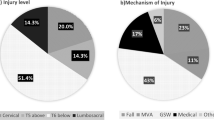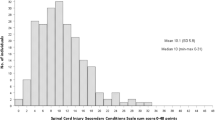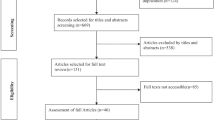Abstract
Introduction:
Increased demands on the upper extremities (UE) have been associated with a higher occurrence of musculoskeletal pain in individuals with spinal cord injury (SCI).
Study design:
This is a cross-sectional retrospective study.
Objective:
The aim of this study was to characterize SCI subjects with musculoskeletal pain in the UE and to determine which variables could predict musculoskeletal pain in these individuals.
Setting:
The study was conducted in SARAH Network of Rehabilitation Hospitals, Brasília, Brazil.
Methods:
Five hundred sixty-four electronic medical records were investigated through a retrospective, exploratory and descriptive analysis to identify individuals with UE pain. A logistic regression model was applied to estimate (odds ratios) whether gender, age, the level of injury, severity of injury, time of injury, body mass index, type of mobility and locomotion aid could predict the occurrence of musculoskeletal pain.
Results:
The prevalence of musculoskeletal pain in the UE was 27.7%. The odds of having musculoskeletal pain were two times higher among woman and tetraplegic patients; those over 41 years of age had twice the frequency of pain than did those <24.7 years; <1 year of injury was a predictor of musculoskeletal pain, compared with the other quartiles (1.1–2.8, 2.9–6.8 and 6.9+ years of injury). There were no differences between the wheelchair and ambulatory individuals.
Conclusion:
Female individuals, those with tetraplegia, aged >40 years and <1 year of injury showed an increased risk of musculoskeletal pain.
Similar content being viewed by others
Log in or create a free account to read this content
Gain free access to this article, as well as selected content from this journal and more on nature.com
or
References
Cripps RA, Lee BB, Wing P, Weerts E, Mackay J, Brown D . A global map for traumatic spinal cord injury epidemiology: towards a living data repository for injury prevention. Spinal Cord 2011; 49: 493–501.
Boninger ML, Waters RL, Chase T, MPJM Dijkers, Gellman H, Gironda RJ et al. Preservation of upper limb function following spinal cord injury: a clinical practice guideline for health-care professionals. J Spinal Cord Med 2005; 28: 433–470.
Dyson-Hudson TA, Kirshblum SC . Shoulder pain in chronic spinal cord injury, Part I: epidemiology, etiology, and pathomechanics. J Spinal Cord Med 2004; 27: 4–17.
Capoor J, Stein AB . Aging with spinal cord injury. Phys Med Rehabil Clin N Am 2005; 16: 129–161.
Dalyan M, Cardenas DD, Gerard B . Upper extremity pain after spinal cord injury. Spinal Cord 1999; 37: 191–195.
Gellman H, Sie I, Waters RL . Late complications of the weight-bearing upper extremity in the paraplegic patient. Clin Orthop Relat Res 1988; 233: 132–135.
Subbarao JV, Klopfstein J, Turpin R . Prevalence and impact of wrist and shoulder pain in patients with spinal cord injury. J Spinal Cord Med 1995; 18: 9–13.
Alm M, Saraste H, Norrbrink C . Shoulder pain in persons with thoracic spinal cord injury: prevalence and characteristics. J Rehabil Med 2008; 40: 277–283.
Pentland WE, Twomey LT . Upper limb function in persons with long term paraplegia and implications for independence: Part I. Paraplegia 1994; 32: 211–218.
American Spinal Injury Association International standards for neurological and functional classification of spinal cord injury, Revised 2000Chicago: ASIA. 2000.
Riek LM, Ludewig PM, Nawoczenski DA . Comparative shoulder kinematics during free standing, standing depression lifts and daily functional activities in persons with paraplegia: considerations for shoulder health. Spinal Cord 2008; 46: 335–343.
McCasland LD, Budiman-Mak E, Weaver FM, Adams E, Miskevics S . Shoulder pain in the traumatically injured spinal cord patient: evaluation of risk factors and function. J Clin Rheumatol 2006; 12: 179–186.
Sie IH, Waters RL, Adkins RH, Gellman H . Upper extremity pain in the postrehabilitation spinal cord injured patient. Arch Phys Med Rehabil 1992; 73: 44–48.
van Drongelen S, de Groot S, Veeger HE, Angenot EL, Dallmeijer AJ, Post MW et al. Upper extremity musculoskeletal pain during and after rehabilitation in wheelchair-using persons with a spinal cord injury. Spinal Cord 2006; 44: 152–159.
Waring WP, Maynard FM . Shoulder pain in acute traumatic quadriplegia. Paraplegia 1991; 29: 37–42.
Eriks-Hoogland IE, Hoekstra T, de GS, Stucki G, Post MW, van der Woude LH . Trajectories of musculoskeletal shoulder pain after spinal cord injury: Identification and predictors. J Spinal Cord Med 2014; 37: 288–298.
Curtis KA, Drysdale GA, Lanza RD, Kolber M, Vitolo RS, West R . Shoulder pain in wheelchair users with tetraplegia and paraplegia. Arch Phys Med Rehabil 1999; 80: 453–457.
Boninger ML, Dicianno BE, Cooper RA, Towers JD, Koontz AM, Souza AL . Shoulder magnetic resonance imaging abnormalities, wheelchair propulsion, and gender. Arch Phys Med Rehabil 2003; 84: 1615–1620.
McColl MA, Charlifue S, Glass C, Lawson N, Savic G . Aging gender, and spinal cord injury. Arch Phys Med Rehabil 2004; 85: 363–367.
Ambrosio F, Boninger ML, Souza AL, Fitzgerald SG, Koontz AM, Cooper RA . Biomechanics and strength of manual wheelchair users. J Spinal Cord Med 2005; 28: 407–414.
Author information
Authors and Affiliations
Corresponding author
Ethics declarations
Competing interests
The authors declare no conflict of interest.
Rights and permissions
About this article
Cite this article
Barbetta, D., Lopes, A., Chagas, F. et al. Predictors of musculoskeletal pain in the upper extremities of individuals with spinal cord injury. Spinal Cord 54, 145–149 (2016). https://doi.org/10.1038/sc.2015.126
Received:
Revised:
Accepted:
Published:
Issue date:
DOI: https://doi.org/10.1038/sc.2015.126
This article is cited by
-
Treatments that are perceived to be helpful for non-neuropathic pain after traumatic spinal cord injury: a multicenter cross-sectional survey
Spinal Cord (2021)
-
Prevalence of upper extremity pain in a population of people with paraplegia
Spinal Cord (2018)
-
Prevalence and associated factors of pain in the Swiss spinal cord injury population
Spinal Cord (2017)



